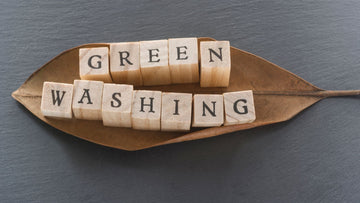7 Ways to Spot Greenwashing When You’re Shopping!
by Kennedy Hammond on Aug 18, 2025

One of the most CRUCIAL steps in your zero waste journey is learning how to detect GREENWASHING!
If you’ve ever picked up a product labeled “eco-friendly” or “natural” & wondered, is this actually good for the planet? You’re not alone. Greenwashing is when companies make products look sustainable through clever marketing, without truly backing it up. The good news is that once you know what to look for, it’s easier to see through the hype and make purchases you actually feel good about. & once you do this, the world will be become scary, because you’ll realize the tricky games these companies play in order to bamboozle us for our hard earned money. It’s BIZARRE.
One of the top 5 questions I get on my social media pages is: “What is greenwashing?” Well, here you go:
greenwashing (noun) — the practice of making a product, company, or organization appear more environmentally friendly than it really is, often through misleading marketing, vague claims, or deceptive labeling.
Pretty easy to grasp right? Well now it’s time to go a little further. Fill your zero waste toolbox with more skills on how to detect GREENWASHING.
HERE WE GO!:
1. Watch Out for Vague Buzzwords
Words like eco-friendly, sustainable, natural, non-toxic, clean often sound good but mean nothing legally. They aren’t regulated, so companies can put them on a label without proof.
Example: Many fast-fashion brands (like H&M with its “Conscious Collection”) used vague terms like “sustainable materials,” while only a tiny fraction of the fabrics were recycled or eco-certified.
Tip: Look for specifics such as “100% organic cotton” or certifications like GOTS, Fair Trade, or USDA Organic.
2. Look for Hidden Trade-Offs
Sometimes a product highlights one “green” feature while ignoring the rest of its footprint.
Example: Plastic water bottles labeled “BPA-free” may sound healthier, but they are still single-use plastic that pollutes landfills & oceans.
Tip: Ask yourself whether the product as a whole is sustainable, or if the brand is distracting you with one nice-sounding feature.
3. Be Skeptical of Nature Imagery
A leaf, a green label, or a picture of a mountain doesn’t mean the product is eco-friendly. Packaging design is one of the oldest greenwashing tricks. Or even when DAWN DISH SOAP uses a picture of a duck on their labeling to signify their products help clean oil spills while packaging their soap in a plastic bottle. Literally made out of oil. BUT OKAY!
Example: Windex’s “Nature’s Source” cleaner (later rebranded) had green leaves & natural vibes all over the bottle, but it contained the same harsh chemicals as their regular formula.
Tip: Don’t let green packaging fool you. Read the ingredients & materials list
4. Check for Third-Party Certifications
True sustainable products usually carry certifications that can be verified. Fake eco-labels are easy to make up.
Example: Some coffee brands market themselves as “sustainably sourced,” but without certifications like Rainforest Alliance or Fair Trade, there is no guarantee that farmers were paid fairly or that the land was protected.
Tip: Trust real certifications (Leaping Bunny for cruelty-free, FSC for paper products, etc.), not just a leafy logo.
5. Investigate Recycling Claims
“Made from recycled materials” sounds great, but often only a small portion of the product is recycled, or it’s not recyclable after use.
Example: Dasani’s PlantBottle campaign made a big deal about using plant-based plastic, but it was still mostly petroleum plastic & it wasn’t biodegradable or widely recyclable.
Tip: Check if the packaging lists the percentage of recycled content, & whether it can actually be recycled in your city.
6. Watch for Irrelevant Claims
Brands sometimes highlight an environmental claim that is irrelevant or misleading.
Example: Some spray cleaners proudly say “CFC-free.” That sounds good, except CFCs (ozone-damaging chemicals) have been banned in the U.S. since 1978, so every cleaner is CFC-free.
Tip: If a label brags about something that should already be the standard, it’s a red flag.
7. Research the Brand’s Bigger Picture
Even if one product seems sustainable, what about the rest of the company?
Example: Nestlé often markets “responsible” bottled water campaigns, while being one of the world’s largest plastic polluters. Similarly, ExxonMobil has run ads highlighting algae biofuel research, while over 99 percent of its investments go into fossil fuels.
Tip: Look beyond one “green” product line & see if the whole brand is aligned with sustainability.




